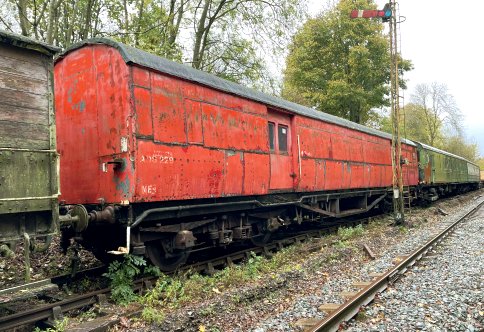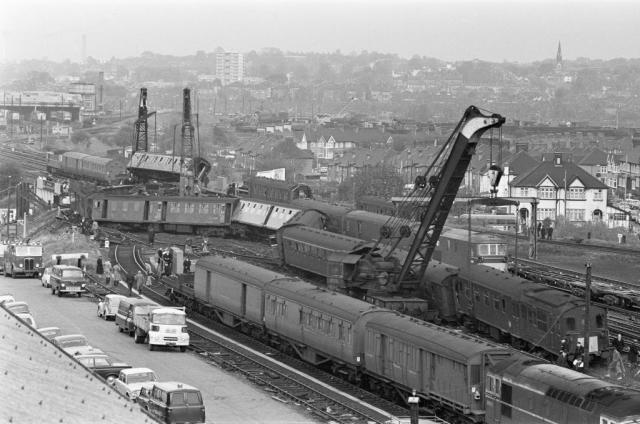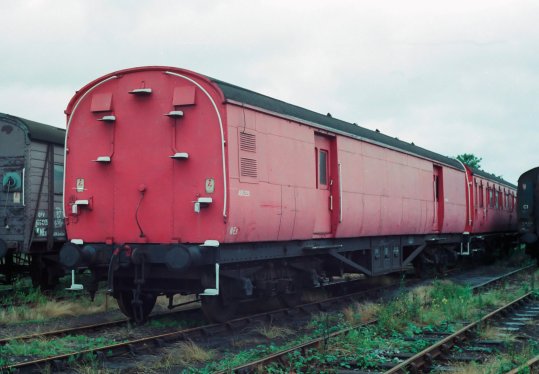 Established 1996
Established 1996
Suburban Electric Railway Association
Support Your Local Train
Southern Railway/BR 'Ironclad' Support Vehicle ADS229

This is the group support vehicle and as such is not considered a restoration project but an asset that fulfils a role providing a space for the volunteer activity that happens on site when working on our locomotives and rolling stock. The vehicle has been in our possession since 1998 but has a very interesting history.
ORIGINS
The 'Ironclad' coaches were a London & South Western design of 57 foot long bogie passenger coaches built from 1921 for the crack express workings on the main line from Waterloo to Southampton and Bournemouth. The got their nickname from the use of flush steel paneling screwed over the hardwood timber body frame to create the outer skin, previous stock had used wood in this capacity, hence they were 'clad in iron' (actually steel). Our example was completed in 1924, after the grouping, so was built by the Southern Railway at Eastleigh Carriage Works. It was an eight compartment third class corridor coach numbered 748, one of a batch of ten built as extra coaches that could be added to formations to either provide extra capacity at busy times or substitute for a vehicle that was out of service for repairs or overhaul. It would have continued in this role for a couple of decades until replaced by newer coaches when it was relegated to less glamourous work, by the 1950s the Ironclads were withdrawn from service when the new British Rail Mark 1 coaches started to be introduced.SECOND LIFE
In 1959 a number of redundant Ironclad coaches were taken over by the engineering department of British Railways (Southern Region) and converted to support coaches for the heavy duty break down cranes based at key locations across the region. For this role our coach was stripped of all its passenger interior, leaving an empty space inside. A handbrake was fitted that worked on one bogie and the wooden floor was replaced by hard wearing cement over steel plate as it needed to carry heavy equipment associated with the operation of the steam cranes. Two large sliding doors were added to each side with the rest of the body covered in flush galvanised steel sheet. At one one part of the roof was replaced with steel section and an internal steel lined compartment was created to house a diesel generator set to provide power when working at remote locations, this end can be identified by the ventilation louvre on the bodyside.
The nature of the breakdown trains was that they did not cover a great deal of mileage each year, they only got called out when there was 'trouble on the line'. This could vary from minor derailments of locos or stock in yards to major incidents, one example of the latter that our vehicle was required to attend was the Hither Green rail crash on 5th November 1967 when a 12 coach Hastings to Charing Cross service derailed at speed and 11 of the 12 coaches came off the track, several over turned. 49 people died and 78 were injured. All four lines of this busy route were shut whilst the wreckage was recovered. Three breakdown cranes were called to the site and the one containing our vehicle would have been one of the first on the scene as it was based at the motive power depot at Hither Green. The picture below shows the recovery in progress and one of the Ironclads is in the lower centre with a second visible to the upper left behind the locomotive.

The breakdown cranes were due for renewal in the 1980s with the steam cranes replaced with diesel electric ones. The support vehicles were also replaced with coaches converted from redundant Mark 1 stock. This left our vehicle as surplus and it was withdrawn from traffic and dumped at New Cross Gate where it is pictured below (photo by Adrian Nichols). When first converted it would have been painted in an all over dark olive livery and we know that it received at least two repaints into red during its time as a support coach. The vehicle retained its vacuum brake equipment but the steam heat aparatus was all removed.

PRESERVATION (of sorts)
The vehicle moved from New Cross Gate to Hoo Junction and from here was sold to a vintage carriage group connected to the Kent and East Sussex Railway, it moved to that line in the late 1980s and was stored with no restoration work being carried out. The group decided to thin down their collection ten years later and the SERA inspected it as a possible candidate for the support vehicle role. The cement floor, large open space and watertight body made it an ideal candidate and the vehicle was purchased and moved to the Coventry Railway Centre in 1998. Here it remained for the next 21 years. The vehicle was fitted with internal racking and strip lighting but has needed very little work in its secondary role as it has rarely needed to be moved, but is still a roling vehicle when needed. The roof was recovered in 2006, the handbrake serviced in 2010 and one side of the body was painted in 2011. When the Electric Railway Museum closed in 2018 the vehicle moved to the Battlefield Railway at Shakerstone where it remains, still doing the job it was aquired for. Some upkeep work is planned for the near future with a full repaint into 1970s red and the four sliding doors need servicing, it would be nice to complete this in time for its 100th birthday in 2024.


